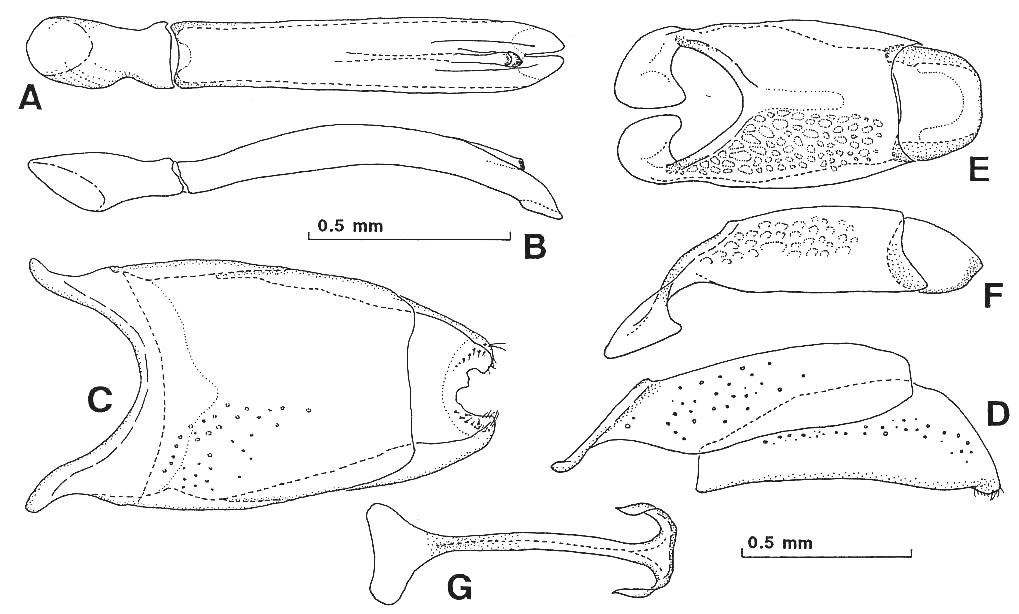
Hypocaccus (Hypocaccus) axeli Kryzhanovskij in Kryzhanovskij and Reichardt, 1976: 223 [Primorskij Kray; Japan: Harima (= Hyôgo)].
Japanese name: Arame-hamabe-emma-mushi.
Description.(Ohara, 1994).
Body length and biometric data as follows: PPL 3.68, PEL 3.36, APW 0. 99, PW 2.57, PL 1.15, EL 2.11, EW 2.76, ProW 1.65 mm, ProL 0.66 mm, PyL 1.12, PTL 0.95, MSTL 0.99, MTTL 1.15. Biometric data are given in Table 49. Body broadly oval and moderately convex. Cuticles shining and black or bronze with brassy lustre; antennae dark piceous with club black; legs dark brown.
Frontal stria of head (Fig. 142A) nearly complete, sometimes interrupted behind bases of antennae. Anterior area of frontal disk with one or two rugae which are arcuate and sometimes irregularly interrupted. Supraorbital stria complete. Epistoma clearly striate on lateral sides, the stria feebly carinate.
Pronotal sides (Fig. 140A) feebly arcuate and convergent on basal four-fifths, thence straight and strongly convergent to apices. Apical angles obtuse. Marginal stria strongly carinate and complete. Disk densely and coarsely punctate except on a mediobasal triangular area, a small mediolateral area and a narrow band inside the marginal stria, the coarse punctures not rugose behind anterior corner; base with two or three irregular rows of coarse punctures, the rows broadest on antescutellar area; elsewhere smooth.
Epipleura of elytra even, and sparsely and finely punctate. Marginal epipleural stria clearly and strongly carinate, and densely with coarse punctures, its apical end extending inwards, reaching to lateral third of posterior margin of elytron. Internal subhumeral stria deeply impressed, strongly crenate and present on median third. Oblique humeral stria present on basal third. First dorsal stria deeply impressed, and nearly complete, its apical portion sinuate. Second dorsal stria present on basal two-thirds. Third and 4th dorsal striae present on basal half; basal end of 4th united with the basal end of sutural stria. First to 4th dorsal striae densely crenate with coarse punctures. Sutural stria deeply impressed and complete. Surface of elytra densely and coarsely punctate except on flanks, extreme apex of elytra, a narrow band between sutural striae, and a medio-basal area inside 4th dorsal striae and occupying basal third of elytra; the punctures as coarse as those of the extreme base of the pronotum and separated by half their diameter, usually appearing to be longitudinal rugae; elsewhere sparsely clothed with microscopic punctures.
Propygidium evenly covered with coarse punctures, which are a little coarser than the elytral ones and separated by about their diameter; interspace among the punctures occasionally finely punctate. Pygidium (Fig. 143E) densely covered with coarse, round and deep punctures, which are a little coarser than the propygidial ones, along lateral margin and on mid line on apical third of pygidium, with a heart shaped impunctate area on apical third.
Anterior margin of median portion of prosternum (Fig. 141A) obtuse-acute. Preapical foveae present. Keel moderately compressed, its anterior apex narrowly truncate. Descending lateral stria strongly carinate and convergent to apex. Carinal stria present on basal three-fourths and distinctly impressed, its basal half gradually divergent basally. Lateral side coarsely punctate medially, and with alutaceous ground microsculptures.
Anterior margin of mesosternum feebly emarginate medially, its marginal stria heavily carinate and complete. Disk smooth. Meso-metasternal suture finely impressed, and with sparsely and coarsely crenate line. Intercoxal disk of metasternum smooth, except in a transverse apical band, which is sparsely and finely punctate. Lateral metasternal stria well impressed, extending obliquely and posteriorly, reaching near hind coxae. Lateral disk covered with large, shallow and round punctures, which are twice as coarse as pygidial punctures, separated by half their diameter and become sparser apically; interspace among the punctures with fine punctures and alutaceous microsculpture. Metepisternum densely covered with coarse punctures, which are a little finer than those of the lateral disk of the metasternum; interspace among the punctures with moderate punctures.
Intercoxal disk of 1st abdominal sternum completely striate on each side, and moderately punctate along the lateral stria, behind anterior corner and in a transverse apical band.
Protibia with 9 spinules on outer margin, the apical two small.
Male genitalia as shown in Fig. 143.

Remarks. Hypocaccul axeli is easily recognized by the rather large size, the pygidium with an impunctated area medially, and the punctation of the pronotum and the elytra.
Little is known about the habitats of this species. It apparently lives on the pebbled beach of mountain rivers.
[Hokkaidô] 1Åâ, Akan, Kushiro, 5/viii/1918, M. Suzuki leg.
[Honshû] <Aomori-ken> 1Åâ, Akaishi River, Ajigasawa-machi, 7/vi/1987, H. Sawada leg. <Nagano-ken> 1Åâ, Kami-kôchi, Pv. Shinano, 27/iii/1918, M. Suzuki leg. (ELKU). <Gifu-ken> 1Åâ, Nagara, Pv. Minô, 19/vii/1919, M. Suzuki leg. (ELKU).